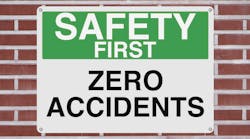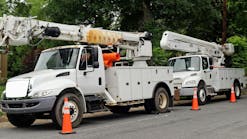Electrical work has always been considered hazardous, and in fact, it is listed in the top 10 of the most dangerous occupations. Someone once put it in a different perspective for me when he said, “We do not work in a dangerous environment; we work in a hazardous environment that we make dangerous by not following safety procedures and not wearing the proper PPE.”
The electricity industry has hazards that are predictable, but it is also very unforgiving. Too often, workers are not following the rules without any negative consequences, resulting in more and more complacency. Each year without fail, we have lineworkers who are injured and killed by not using the proper personal protective equipment (PPE) and cover when working near energized lines and equipment. Observations from a recent review of electrical fatalities, which pertained to contact with energized lines and equipment, indicated that failure to follow proper procedure was part of every failure listed. Experience and training did not appear to be an issue in most cases.
As an industry, should we not have grown past the point that would get us out of the top 10? Current rules and regulations would protect every electricity worker in almost every case if they were followed. I strongly believe that zero fatalities and serious injuries are possible in our industry.
Why Do Accidents Happen?
Accidents happen for one or both of the following reasons: unsafe acts or unsafe conditions. We are told that 80% to 90% of accidents occur because of the unsafe actions of individuals; my belief is that 100% of all accidents are the result of either the action or inaction of some individual somewhere, sometime.
The lineworker experiencing the accident may not be the one who caused it, but somewhere, sometime, there was an act or a failure to act by someone, which created the circumstances for what took place.
Why Someone May Not Insist On Compliance
Daily, there are situations where a supervisor and crew members may not perceive a situation as being hazardous or an action as unsafe. This can happen where in the past, the seriousness of risk has been overlooked or ignored because those involved have previously engaged in similar behavior.
They may think that given the level of risk, it just does not warrant work stoppage. This can happen when the work is thought to be more important than eliminating the hazard. Also, the task may only take just a couple of minutes, is low risk, or the lineworker is experienced. Therefore, it is perceived that there is no need to stop the work.
Other reasons why employees may not insist on compliance:
• They may not want to alienate the other person.
• They may be influenced by peer pressure not to speak up.
• The potentially unsafe act may be performed by someone with more experience or who has been with the organization for a longer period of time.
• They may be fearful of misinterpreting the situation.
Becoming a Safety Leader
With the proper support and guidance, anyone can be a safety leader in your organization, and anyone can learn the skills and behaviors needed to be a safety leader. If organizations are truly committed to achieving a zero-injury workplace, they must help those that work in our industry to gain a better understanding of what it takes to be effective safety leaders.
Leadership Is Not Power
We need leaders who have the capacity to bring about the desired outcomes and prevent the outcomes that are not desired. Leadership cannot be derived from status or position. Position may enhance the opportunity for leadership, and there are many who have status or position, but they have no idea how to lead. One’s position is typically assigned from above, but leadership comes from below.
Cultivating a Safe Work Culture
Do you have bosses in the field or do you have leaders? The difference between the two can have a very dramatic impact on safety performance. Bosses primarily manage to control, and leaders primarily manage to support, and if you have high-level leaders, they will also inspire.
The leader naturally sets the tone of the safety culture and that has a direct effect on morale and performance. Whatever the leader gives to their crew, it will be given back. Whatever the leader expects will be expected of them. For example:
• If a leader wants employees who care about their work, he or she must demonstrate care for employees.
• If a leader desires honest and fair employee behavior, he or she must treat employees with honesty and fairness.
• If a leader expects selfless employee performance, he or she must be selfless.
• If a leader expects employee loyalty, they must be loyal to those they lead.
Leaders get what they give. If a supervisor wants to be trusted, they must trust. If they want commitment from the crew, they have to demonstrate commitment. Everything the crew
leader does creates a story that the crew will talk about in the bull room.
The law of cause and effect is very well established. In order to be successful as a crew leader, you must be a tough-caring leader. Tough-caring leaders insist on safety compliance, (it cannot just be encouraged) because they care about the safety, and success of their crew.
When I spend time in the field, I find sometimes that the crew supervisor is controlling. This type of supervisor is tough on his crew to make sure they do not get themselves in trouble, because it’s policy, because they consider themselves superior to their subordinates and because they are more interested in their own success than in the success of those who they supervise.
The worst type of leader I find in the field is the coercive leader. These supervisors lack control and are fearful of their supervision. They lack confidence, and as such, they create fear in their crew to get things done. They believe the only way to get things done the way they want to is by intimidation and coercion. The controlling and the coercive supervisor will not be successful.
When effective safety leadership is present, employees not only feel responsible for their own safety, they feel responsible for their coworker’s safety. A strong organizational safety culture supports them acting on that responsibility.
If an organization can learn these leadership qualities and commit to teaching them to the entire workforce, only then will it expand its ability to lead its company in pursuit of a zero-injury workplace.
Mike Bahr is a safety consultant and has been a safety professional in the electrical utility/construction industry for more than 30 years.
QUALITIES OF A SUCCESSFUL LEADER IN THE UTILITY INDUSTRY
In order to achieve a zero-injury workplace, we must have safety leaders, who possess, among others, the following qualities, which through experience, become mastered skills, according to the book, Leadership Secrets of Attila the Hun, by Wes Roberts, Ph.D.
1. Loyalty. Above all, a leader must be loyal. This is a highly valued character trait that is desired between employers and employees. All crews as well as the organization hangs together or falls apart because loyalty. Loyalty, trust and commitment is the glue that holds our crews together. The crew looks to their supervisor for solutions to issues. If the supervisor does not provide help, concerns of his or her ineffectiveness add to the crews’ frustration, leading to loss of loyalty. Leaders must convey the message that actions are being taken to find ways to fix the problem. A supervisor simply cannot ignore the problem, or it will lead to dissatisfaction.
2. Courage. Leaders must have courage to carry out their assignments. Above all, they must have the courage to always insist on compliance.
3. Desire. Without a strong desire and commitment to influencing people, it is difficult for supervisors to sustain themselves as safety leaders.
4. Emotional Stamina. Each higher level of leadership places increasing demands on the emotions of supervision. Leaders must have the emotional stamina to recover from disappointment.
5. Physical Stamina. Employees must have leaders who can endure the physical demands of their leadership duties.
6. Empathy. Leaders must have an appreciation for and an understanding of the values and opinions of others.
7. Decisiveness. Supervisors must be decisive, knowing when to act and when not to act, taking into account all the facts of the situation and then responsibly carrying out their leadership role.
8. Anticipation. Learning by observation and through instincts sharpened and by experience, leaders must anticipate thoughts, actions and consequences.
9. Timing. Essential to all acts of leadership is the timing of recommendations and actions.
10. Competitiveness. An essential quality of leadership is a desire to win.
11. Self-Confidence. Proper training and experience develop in leaders a personal feeling of assurance with which to meet the inherent challenges of leadership.
12. Accountability. Learning to account for personal actions and those of subordinates is fundamental to leadership. Supervision must never heap praise or lay blame on others for what they themselves
achieve or fail to accomplish, no matter how glorious or grave the consequences. When leaders take personal accountability, they are willing to answer for the outcomes of their choices, their behaviors, and their actions in all situations in which they are involved. Accountable leaders do not blame others when things go sideways. Rather, they make things right. Accountable leaders assume ownership for the performance of their team.
13. Responsibility. Leaders are responsible to see that actions are carried out and directions followed. No supervisor should ever be allowed to serve who will not accept full responsibility for his actions.
14. Credibility. Leaders must be credible. His or her words and actions must be believable to everyone. They must be trusted to have the intelligence and integrity to provide correct information.
15. Tenacity. The quality of unyielding drive to accomplish assignments is a desirable and essential quality of leadership. The weak persist only when things go their way.
16. Dependability. If a supervisor cannot be depended upon in all situations to carry out his roles and responsibilities, relieve him or her of them. A manager cannot observe each action of his subordinates;
therefore, he or she must depend upon them to get things done.
17. Stewardship. Leaders must have the essential quality of stewardship, a caretaker quality. They must serve in a manner that encourages confidence, trust and loyalty. Subordinates (apprentices) are not to be abused; they are to be guided, developed and rewarded for their performance.


